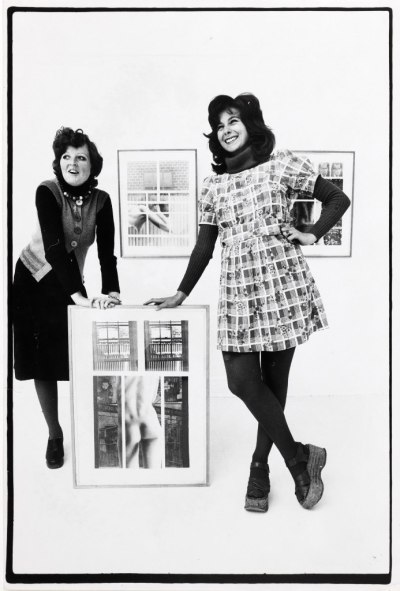In the 1970s, Janine Burke was a key member of the community of artists, writers and curators associated with the Ewing and George Paton galleries at Melbourne University Student Union.

Janine (left) and Kiffy
Always the heart and centre was Kiffy Rubbo, well assisted by Meredith Rogers.
1974 at the Ewing Gallery : a performance with theremin by Phillipa Cullen as part of 'Events/Structures' curated by Peter Cripps. Peter is squatting at the back; beside him is Aleks Danko, with beard, and standing beside Aleks is Jennifer Phipps, an NGV curator through the 1970s. Kiffy is seated on the floor, back to the wall, on the right. photo by FIAPCE
In 2014, Janine Burke organised a commemorative seminar at Melbourne University :
Curating the 1970s'
Following on from that, published last month, is
Kiffy Rubbo: curating the 1970s, edited by Janine Burke and Helen Hughes.

In this weekend's The Age/SMH, is this review by Owen Richardson :
Following on from that, published last month, is
Kiffy Rubbo: curating the 1970s, edited by Janine Burke and Helen Hughes.

In this weekend's The Age/SMH, is this review by Owen Richardson :
Kiffy Rubbo: Curating the Seventies
Editors Janine Burke and Helen Hughes
SCRIBE, $29.99
Review by Owen Richardson
Kiffy Rubbo ran the George Paton Gallery at the Melbourne University Student Union from 1971 to 1979. These were years of upheaval in the art world, here and abroad, and on the local scene the George Paton lead the way in new developments: photography and feminist, conceptual and performance art all found a home there under Rubbo's leadership.
It was the period of trailblazing feminist art historian Lucy Lippard's visit to Melbourne, and the artists' sit-in at the National Gallery organised by Rubbo as a protest against the gallery's censorship of Domenico De Clario's work, and the founding of the Women's Art Register. It was also the time of Stelarc spending 10 days lying between two metal plates, surrounded by bottles of his bodily fluids, and Jill Orr's Inside Jack's Head, which featured a sheep's carcass and a busload of Grade Five children and provides us with a convenient image for the freedoms of the era.
 This collection is a companion to 2009's exhibition and catalogue When You Think About Art: Ewing and George Paton Gallery 1971-2008, and its brief is to focus on the woman who did so much to help make these things happen. Alongside the editors, Orr and Stelarc provide memoirs, as do Lyndal Jones and Peter Tyndall, among others, and the impression of a distinctive and highly attractive personality comes through.
This collection is a companion to 2009's exhibition and catalogue When You Think About Art: Ewing and George Paton Gallery 1971-2008, and its brief is to focus on the woman who did so much to help make these things happen. Alongside the editors, Orr and Stelarc provide memoirs, as do Lyndal Jones and Peter Tyndall, among others, and the impression of a distinctive and highly attractive personality comes through. It sounds as if Rubbo was exactly what the times demanded: professional and disciplined while also open and free-thinking, strong and decisive at the same time as being inclusive and uninterested in self-aggrandisement. She had the benefit of a cultured, intellectual background: her father was a distinguished scientist, her grandfather a painter, one of her brothers a filmmaker and another a bookseller. Yet despite her advantages, beneath the outward energy and charm lay a self-doubting and troubled person: when she left the GPG she had difficulty reorienting herself and in 1980 took her own life.
We don't have to take the contributors' word for Kiffy's personal magnetism. The last 40 pages reproduce some of her letters to her brother Michael, and the liveliness and questing mind and humour are all there, as are the moments of sadness and anxiety.
One is left with a real sense of lost potential: it is hard not to feel that the culture of the past 35 years has been the poorer without Kiffy Rubbo's ongoing contribution. But this book testifies to what she gave in her time.

Kiffy Rubbo 2, 1979
by Robert Rooney
1979 (printed 2012 as inkjet print)
collection National Portrait Gallery
detail
A Person Looks At A Work Of Art/
someone looks at something...
LOGOS/HA HA



